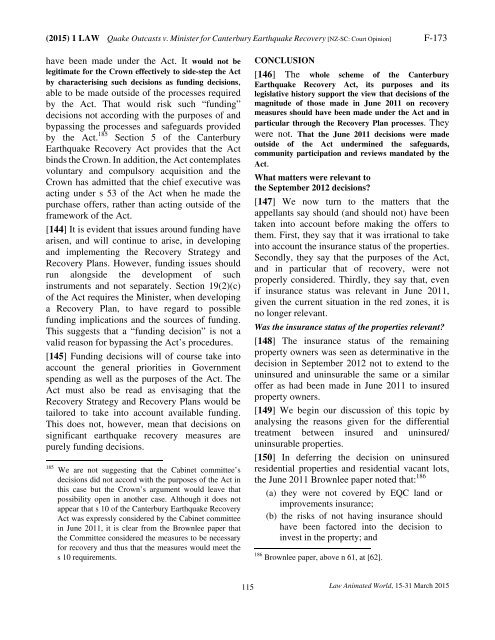Editor: I. Mallikarjuna Sharma Volume 11: 15-31 March 2015 No. 5-6
Martyrs memorial special issue of 15-31 March 2015 paying tributes to Bhagat Singh and other comrades.
Martyrs memorial special issue of 15-31 March 2015 paying tributes to Bhagat Singh and other comrades.
You also want an ePaper? Increase the reach of your titles
YUMPU automatically turns print PDFs into web optimized ePapers that Google loves.
(20<strong>15</strong>) 1 LAW Quake Outcasts v. Minister for Canterbury Earthquake Recovery [NZ-SC: Court Opinion] F-173<br />
have been made under the Act. It would not be<br />
legitimate for the Crown effectively to side-step the Act<br />
by characterising such decisions as funding decisions,<br />
able to be made outside of the processes required<br />
by the Act. That would risk such “funding”<br />
decisions not according with the purposes of and<br />
bypassing the processes and safeguards provided<br />
by the Act. 185 Section 5 of the Canterbury<br />
Earthquake Recovery Act provides that the Act<br />
binds the Crown. In addition, the Act contemplates<br />
voluntary and compulsory acquisition and the<br />
Crown has admitted that the chief executive was<br />
acting under s 53 of the Act when he made the<br />
purchase offers, rather than acting outside of the<br />
framework of the Act.<br />
[144] It is evident that issues around funding have<br />
arisen, and will continue to arise, in developing<br />
and implementing the Recovery Strategy and<br />
Recovery Plans. However, funding issues should<br />
run alongside the development of such<br />
instruments and not separately. Section 19(2)(c)<br />
of the Act requires the Minister, when developing<br />
a Recovery Plan, to have regard to possible<br />
funding implications and the sources of funding.<br />
This suggests that a “funding decision” is not a<br />
valid reason for bypassing the Act’s procedures.<br />
[145] Funding decisions will of course take into<br />
account the general priorities in Government<br />
spending as well as the purposes of the Act. The<br />
Act must also be read as envisaging that the<br />
Recovery Strategy and Recovery Plans would be<br />
tailored to take into account available funding.<br />
This does not, however, mean that decisions on<br />
significant earthquake recovery measures are<br />
purely funding decisions.<br />
185 We are not suggesting that the Cabinet committee’s<br />
decisions did not accord with the purposes of the Act in<br />
this case but the Crown’s argument would leave that<br />
possibility open in another case. Although it does not<br />
appear that s 10 of the Canterbury Earthquake Recovery<br />
Act was expressly considered by the Cabinet committee<br />
in June 20<strong>11</strong>, it is clear from the Brownlee paper that<br />
the Committee considered the measures to be necessary<br />
for recovery and thus that the measures would meet the<br />
s 10 requirements.<br />
CONCLUSION<br />
[146] The whole scheme of the Canterbury<br />
Earthquake Recovery Act, its purposes and its<br />
legislative history support the view that decisions of the<br />
magnitude of those made in June 20<strong>11</strong> on recovery<br />
measures should have been made under the Act and in<br />
particular through the Recovery Plan processes. They<br />
were not. That the June 20<strong>11</strong> decisions were made<br />
outside of the Act undermined the safeguards,<br />
community participation and reviews mandated by the<br />
Act.<br />
What matters were relevant to<br />
the September 2012 decisions?<br />
[147] We now turn to the matters that the<br />
appellants say should (and should not) have been<br />
taken into account before making the offers to<br />
them. First, they say that it was irrational to take<br />
into account the insurance status of the properties.<br />
Secondly, they say that the purposes of the Act,<br />
and in particular that of recovery, were not<br />
properly considered. Thirdly, they say that, even<br />
if insurance status was relevant in June 20<strong>11</strong>,<br />
given the current situation in the red zones, it is<br />
no longer relevant.<br />
Was the insurance status of the properties relevant?<br />
[148] The insurance status of the remaining<br />
property owners was seen as determinative in the<br />
decision in September 2012 not to extend to the<br />
uninsured and uninsurable the same or a similar<br />
offer as had been made in June 20<strong>11</strong> to insured<br />
property owners.<br />
[149] We begin our discussion of this topic by<br />
analysing the reasons given for the differential<br />
treatment between insured and uninsured/<br />
uninsurable properties.<br />
[<strong>15</strong>0] In deferring the decision on uninsured<br />
residential properties and residential vacant lots,<br />
the June 20<strong>11</strong> Brownlee paper noted that: 186<br />
(a) they were not covered by EQC land or<br />
improvements insurance;<br />
(b) the risks of not having insurance should<br />
have been factored into the decision to<br />
invest in the property; and<br />
186 Brownlee paper, above n 61, at [62].<br />
<strong>11</strong>5<br />
Law Animated World, <strong>15</strong>-<strong>31</strong> <strong>March</strong> 20<strong>15</strong>



